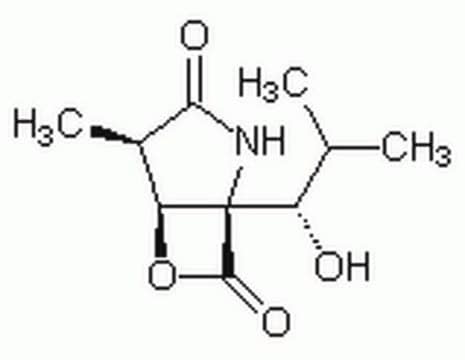おすすめの製品
アッセイ
≥95% (HPLC)
品質水準
形状
film
溶解性
DMSO: soluble 25 mg/mL
保管温度
−20°C
SMILES記法
[H][C@@]12OC(=O)[C@@]1(NC(=O)[C@@H]2C)[C@@H](O)C(C)C
InChI
1S/C10H15NO4/c1-4(2)6(12)10-7(15-9(10)14)5(3)8(13)11-10/h4-7,12H,1-3H3,(H,11,13)/t5-,6+,7+,10-/m1/s1
InChI Key
FWPWHHUJACGNMZ-NBBQQVJHSA-N
アプリケーション
Clasto-Lactacystin β-lactone has been used as a proteasomal inhibitor.
Clasto-Lactacystin β-lactone has been used as a protein degradation inhibitor to test its effect on memory improvements in mice. It has also been used as a proteasome inhibitor in human ovarian surface epithelium (HOSE) cells and dendritic cells (DCs).
生物化学的/生理学的作用
細胞透過性の不可逆的プロテオソ-ムインヒビタ-です。ラクタシスチンは、clasto-ラクタシスチンβ-ラクトンの前駆体として作用します。
Clasto-Lactacystin β-lactone (cLβL) is synthesized from lactacystin. It is cell-permeable and cLβL acts on the N-terminal threonine of subunit proteasome β -subunit X It also inhibits 20S proteasome activity in Haloferax volcanii by acting in the N-threonine residue of the β -type subunits.
シグナルワード
Warning
危険有害性情報
危険有害性の分類
Eye Irrit. 2
保管分類コード
11 - Combustible Solids
WGK
WGK 2
引火点(°F)
Not applicable
引火点(℃)
Not applicable
適用法令
試験研究用途を考慮した関連法令を主に挙げております。化学物質以外については、一部の情報のみ提供しています。 製品を安全かつ合法的に使用することは、使用者の義務です。最新情報により修正される場合があります。WEBの反映には時間を要することがあるため、適宜SDSをご参照ください。
労働安全衛生法名称等を表示すべき危険物及び有害物
名称等を表示すべき危険物及び有害物
労働安全衛生法名称等を通知すべき危険物及び有害物
名称等を通知すべき危険物及び有害物
Jan Code
L7035-BULK:
L7035-.1MG-PW:
L7035-.1MG:
L7035-VAR:
試験成績書(COA)
製品のロット番号・バッチ番号を入力して、試験成績書(COA) を検索できます。ロット番号・バッチ番号は、製品ラベルに「Lot」または「Batch」に続いて記載されています。
この製品を見ている人はこちらもチェック
Kristen Willeumier et al.
The Journal of neuroscience : the official journal of the Society for Neuroscience, 26(44), 11333-11341 (2006-11-03)
The ubiquitin proteasome system, generally known for its function in protein degradation, also appears to play an important role in regulating membrane trafficking. A role for the proteasome in regulating presynaptic release and vesicle trafficking has been proposed for invertebrates
Florian Vogel et al.
Traffic (Copenhagen, Denmark), 8(9), 1205-1214 (2007-07-17)
Intracellular trafficking of viral movement proteins (MPs) in plants has mainly been studied using Tobacco mosaic virus MP30 (TMV MP30) as a model system. Because of the limitations of TMV MP30 expression in Arabidopsis thaliana, these studies have mostly been
Coordinated regulation of dendrite arborization by epigenetic factors CDYL and EZH2
Qi C, et al.
The Journal of Neuroscience, 34(13), 4494-4508 (2014)
Sue-Hyun Lee et al.
Science (New York, N.Y.), 319(5867), 1253-1256 (2008-02-09)
Reactivated memory undergoes a rebuilding process that depends on de novo protein synthesis. This suggests that retrieval is dynamic and serves to incorporate new information into preexisting memories. However, little is known about whether or not protein degradation is involved
L R Dick et al.
The Journal of biological chemistry, 272(1), 182-188 (1997-01-03)
The natural product lactacystin exerts its cellular antiproliferative effects through a mechanism involving acylation and inhibition of the proteasome, a cytosolic proteinase complex that is an essential component of the ubiquitin-proteasome pathway for intracellular protein degradation. In vitro, lactacystin does
資料
DISCOVER Bioactive Small Molecules for Nitric Oxide & Cell Stress Research
ライフサイエンス、有機合成、材料科学、クロマトグラフィー、分析など、あらゆる分野の研究に経験のあるメンバーがおります。.
製品に関するお問い合わせはこちら(テクニカルサービス)














